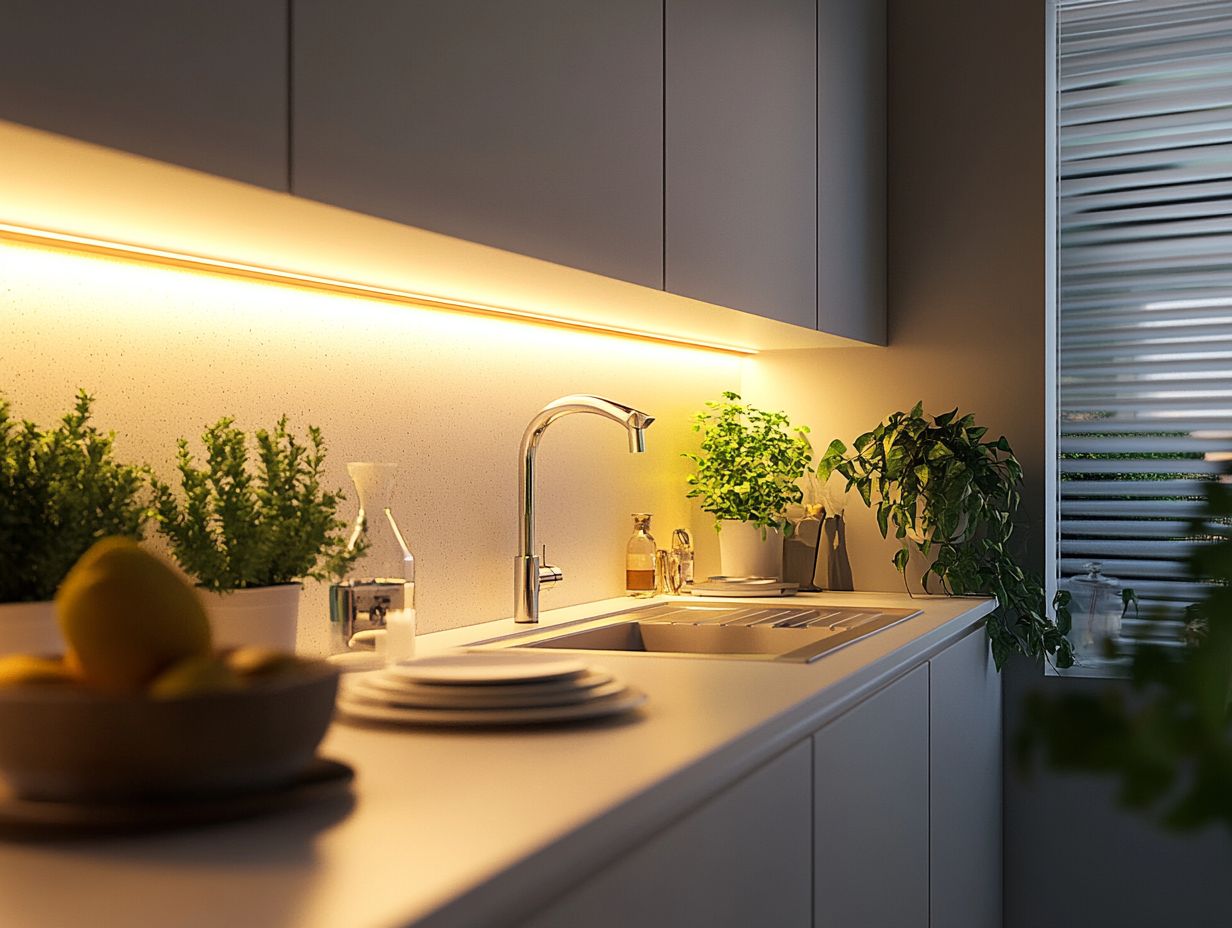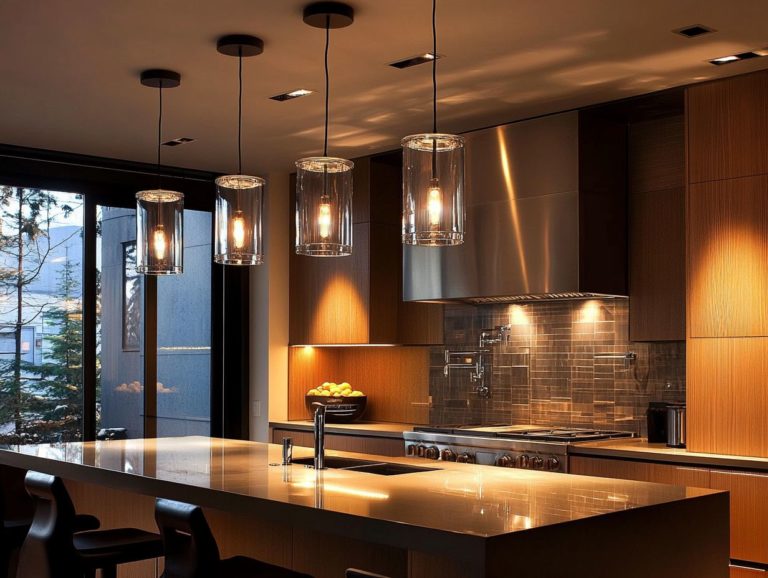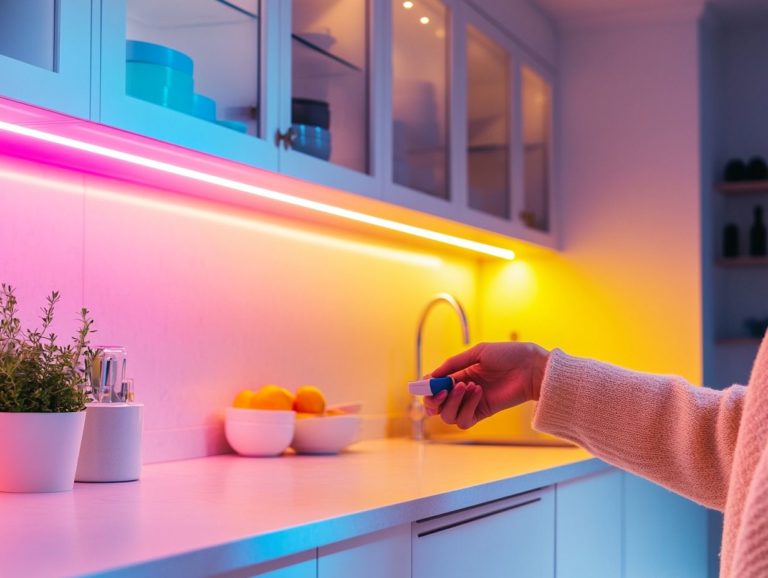Choosing Energy-Efficient Lighting for Your Kitchen
In today’s world, where sustainability seamlessly intertwines with functionality, the lighting choices in your kitchen can significantly impact not just the environment but also your finances. By opting for energy-efficient lighting options like LEDs, CFLs, and halogens, you can create a brighter, more inviting cooking space while slashing your energy consumption.
This article covers the many benefits of these lighting types, key factors to consider for optimal placement, and practical installation tips you can easily implement. With a thorough cost comparison at your fingertips, you’ll discover how investing in energy-efficient lighting can translate into substantial long-term savings.
Join us as we explore the path to a greener, more efficient kitchen!
Contents
- Key Takeaways:
- The Importance of Energy-Efficient Lighting in the Kitchen
- Types of Energy-Efficient Lighting
- Factors to Consider When Choosing Lighting
- Installation and Maintenance Tips
- Proper Installation Techniques
- Maintenance and Replacement Guidelines
- Cost Comparison of Energy-Efficient Lighting
- Initial Costs and Long-Term Savings
- Frequently Asked Questions
- Why should I choose energy-efficient lighting for my kitchen?
- What types of energy-efficient lighting should I consider for my kitchen?
- How do I determine the right brightness for my kitchen lighting?
- What is the best placement for energy-efficient lighting in my kitchen?
- Are there any energy-efficient lighting options for decorative purposes in my kitchen?
- What are some other tips for choosing energy-efficient lighting for my kitchen?
Key Takeaways:

- Choosing energy-efficient lighting benefits both the environment and your wallet, reducing energy consumption and saving money in the long run.
- LED, CFL, and halogen lights are the most popular types of energy-efficient lighting, each with their unique advantages and considerations.
- When choosing lighting for your kitchen, consider placement and functionality, as well as color temperature and brightness for optimal lighting and ambiance.
The Importance of Energy-Efficient Lighting in the Kitchen
Energy-efficient lighting is essential in contemporary kitchen design, influencing both the functionality and ambiance of your cooking space. Choose LED bulbs for an inviting atmosphere while simultaneously lowering energy consumption.
This approach not only supports environmental sustainability but also results in noteworthy savings on your utility bills, making it a savvy choice for anyone considering a kitchen renovation. Integrating energy-efficient lighting systems elevates the entire kitchen experience, ensuring that every culinary task is brilliantly illuminated without sacrificing style.
Benefits for the Environment and Your Wallet
Utilizing energy-efficient lighting options in your kitchen not only conserves energy but also leads to significant savings on your electricity bill. By opting for technologies like LED, CFL, and halogen bulbs, you can drastically reduce your energy costs over time.
These light sources consume less electricity than traditional incandescent bulbs while boasting longer lifespans, meaning fewer replacements and less waste. Beyond just the financial perks, embracing sustainable lighting solutions contributes to a healthier planet. You’ll be helping to lower carbon footprints and reduce reliance on fossil fuels.
As energy-efficient lighting becomes more mainstream, its role in daily life continues to expand. This makes it a wise choice for anyone eager to enhance their home’s efficiency while being environmentally conscious.
Types of Energy-Efficient Lighting
When considering energy-efficient lighting for your kitchen, several options emerge as frontrunners—LED bulbs, CFLs, and halogen fixtures each bring unique benefits tailored to your specific lighting needs and aesthetic preferences.
LED bulbs, celebrated for their impressive lifespan and minimal energy consumption, offer a brilliant solution for ambient lighting. On the other hand, CFL bulbs present a more budget-friendly option for general illumination. While halogen lighting might not be as efficient as its peers, it excels in delivering exceptional color temperature, making it a popular choice for task-oriented lighting in kitchens.
By familiarizing yourself with the different types of energy-efficient lighting available, you can handpick the ideal fixtures that elevate both the functionality and style of your culinary space.
Don’t miss out on significant savings! Transform your kitchen today for a brighter future!
LED, CFL, and Halogen Options
LED, CFL, and halogen lights are three excellent choices for energy-efficient lighting. Each option has unique characteristics and benefits tailored to your kitchen needs.
LED lights truly shine with their impressive longevity and minimal energy consumption. They are a smart, sustainable option for anyone looking to reduce their carbon footprint.
CFLs offer a softer glow with a warm color temperature, creating a cozy atmosphere. However, they may require a moment to reach their full brightness.
Halogen bulbs, while a bit more energy-hungry, provide a sharp, bright light that’s perfect for task-driven areas in the kitchen. Keep in mind that they generate more heat, which can influence overall energy consumption.
By understanding these distinctions, you can make an informed choice that aligns perfectly with your specific lighting preferences and environmental goals.
Factors to Consider When Choosing Lighting

Selecting the ideal lighting for your kitchen requires thoughtful consideration of several essential factors. These include placement, functionality, color temperature, and brightness tailored to your specific needs.
The layout of your cooking space, along with the interplay of different lighting styles, profoundly influences both ambiance and usability.
For instance, under-cabinet lighting beautifully enhances your countertop illumination. Pendant lamps can act as striking accent pieces.
Understanding the desired mood with warm or cool light elevates your kitchen environment. This transformation creates a comfortable and inviting space for both cooking and gathering.
Lighting Placement and Functionality
Effective lighting placement is essential for maximizing functionality in your kitchen. It ensures that every task is brilliantly illuminated and easily manageable.
By strategically incorporating various types of lighting, you can transform your culinary space into a more efficient and enjoyable environment.
Task-specific lighting, like under-cabinet lights, provides clarity by eliminating shadows and enhancing visibility while you chop or measure. This ensures you have the clarity you need when it matters most.
Countertop lighting enhances visibility during food preparation, allowing you to see the fine details of your dishes with ease.
Knowing how important these elements are reveals how they can greatly enhance not only the aesthetic appeal of your kitchen but also your overall cooking experience. This ensures that every meal you create is a resounding success.
Color Temperature and Brightness
Getting color temperature and brightness right is crucial for creating the perfect kitchen vibe! These elements influence both your mood and the space’s functionality.
Warm light, typically ranging from 2700K to 3000K, creates an inviting and cozy atmosphere. It’s ideal for family gatherings or delightful evening meals.
On the flip side, cooler temperatures, usually between 3500K and 5000K, offer a more energizing and focused setting. This is perfect for meal preparation and cooking tasks.
The quality of your lighting matters too, especially in task-specific areas like countertops and stovetops. You want enough light, measured in lumens (a unit that measures light output), to make sure every corner is bright, enhancing safety and efficiency.
By balancing these elements, you not only boost comfort but also elevate your overall cooking experience to a whole new level.
Installation and Maintenance Tips
Proper installation and maintenance of your kitchen lighting are essential for maximizing the performance and longevity of your fixtures. This ultimately elevates both functionality and ambiance.
To achieve the best results, it’s crucial to adhere to established guidelines and techniques during installation. This means ensuring adequate wiring and aligning with safety standards.
Regular maintenance, such as cleaning your fixtures and checking bulb conditions, plays a significant role in maintaining energy efficiency and lighting quality.
By doing so, you ensure that your kitchen remains a well-lit and inviting space, perfect for both cooking and entertaining.
Proper Installation Techniques
Adhering to proper installation techniques is essential for ensuring both safety and efficiency when setting up kitchen lighting fixtures. By following established electrical guidelines during your installation, you can dramatically lower the chances of dangerous accidents with the right setup!
Begin by turning off the power at the circuit breaker to protect yourself from accidental shocks. Next, ensure that your chosen light fixtures comply with local regulations. This highlights the importance of using the right wiring and connectors.
Consulting a licensed electrician for specific requirements is a wise move. They can help verify that the power your new lights will use won’t exceed the circuit’s capacity. By prioritizing effective installation practices, you enhance your kitchen’s illumination while fostering a secure environment in your home.
Maintenance and Replacement Guidelines

Regular maintenance and timely replacement of your kitchen lighting fixtures are essential for maintaining energy efficiency and optimal illumination. By cleaning your light fixtures frequently, you eliminate dust and grime, allowing for maximum brightness without increasing energy consumption.
It’s important to check the health of your bulbs periodically. Flickering or dim bulbs can fail to provide adequate lighting and signal inefficiencies that could drive up your electricity costs.
Consider replacing incandescent bulbs with more durable, energy-saving options like LEDs. This switch will enhance the longevity of your fixtures and reduce overall energy usage.
Keeping track of the lifespan of various types of lighting helps you anticipate replacement needs, ensuring your kitchen remains functional and inviting.
Cost Comparison of Energy-Efficient Lighting
A thorough cost comparison of energy-efficient lighting options uncovers notable disparities between initial expenses and long-term savings. This underscores the importance of well-considered choices in your kitchen renovation projects.
Although LED bulbs may demand a higher upfront investment compared to traditional fixtures, their durability and minimal energy consumption lead to significant savings over time.
By grasping these financial dynamics, you can make savvy choices that elevate the aesthetic appeal of your kitchen while championing energy efficiency and sustainability for the future.
Initial Costs and Long-Term Savings
When evaluating the initial costs and long-term savings of energy-efficient lighting, consider both the upfront investment and the cumulative financial benefits over time.
Traditional incandescent bulbs might catch your eye with their lower purchase price. However, their higher energy consumption can lead to significantly more expensive electricity bills down the line.
On the other hand, LED options, while pricier at the outset, typically consume up to 80% less energy and have longer lifespans. This means you’ll spend less on replacements and require less maintenance.
By adopting a structured financial planning approach, you can effectively assess the return on investment (ROI) when transitioning to energy-efficient systems, analyzing the broader impact on your budget.
The decisions you make today can lead to substantial financial advantages in the future.
Frequently Asked Questions
Why should I choose energy-efficient lighting for my kitchen?
Choosing energy-efficient lighting helps to reduce your carbon footprint, save money on energy bills, and provides better quality lighting that enhances the ambiance and functionality of your kitchen.
What types of energy-efficient lighting should I consider for my kitchen?

There are several options for energy-efficient lighting, including LED (Light Emitting Diode), CFL (Compact Fluorescent Lamp), and halogen bulbs. LED bulbs are the most energy-efficient and have a longer lifespan, while CFL bulbs are a more affordable option.
Make the switch today for a brighter, more efficient kitchen!
How do I determine the right brightness for my kitchen lighting?
Your kitchen’s brightness depends on its size and layout. Aim for 50-100 lumens per square foot for ambient lighting and 300-500 lumens for task lighting.
What is the best placement for energy-efficient lighting in my kitchen?
Place energy-efficient lighting strategically for various tasks. Recessed lighting works well for ambient light, while under-cabinet lighting is great for tasks.
Are there any energy-efficient lighting options for decorative purposes in my kitchen?
Yes, you can use energy-efficient decorative lighting. Consider LED strip lights or fixtures with LED or CFL bulbs for style and efficiency.
What are some other tips for choosing energy-efficient lighting for my kitchen?
Select energy-efficient bulbs and consider using dimmer switches to cut energy use. Remember to turn off lights when not in use and keep fixtures clean for optimal performance.





